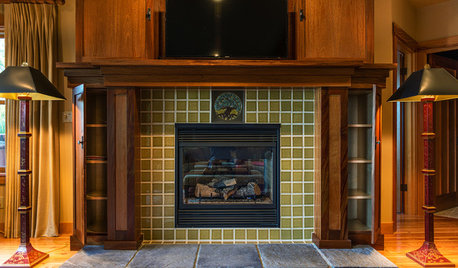Can romex be put in conduit?
steve340
17 years ago
Related Stories

DESIGN DICTIONARYConduit
A conduit inside a building serves as a channel for electrical cables and wires
Full Story0

BATHROOM WORKBOOKHow to Get Your Bathroom Vanity Lighting Right
Create a successful lighting plan with tips on where to mount fixtures and other design considerations
Full Story
MOST POPULAR5 Ways to Hide That Big Air Conditioner in Your Yard
Don’t sweat that boxy A/C unit. Here’s how to place it out of sight and out of mind
Full Story
ENTERTAININGTips for Squeezing in More Guest Beds
Put up your overnight guests in comfort and style with these sofa bed, bed and mattress options
Full Story
ACCESSORIESDesigns Worth Discovering: Rookwood Pottery Tile
Get to know the company that put American ceramics on the map in the 1880s to see why its tiles are newly popular today
Full Story
ENTRYWAYSNo Entryway? Create the Illusion of One
Create the feeling of an entry hall even when your door opens straight into the living room. Here are 12 tricks to try
Full Story
LANDSCAPE DESIGNWhen Less Is Really More in Your Garden
8 ways you can make a powerful garden statement by embracing simplicity and surroundings
Full Story
WINDOW TREATMENTSThe Case for Stationary Draperies
Curtains that open and close are great in some situations, but stationary draperies can give you a better view (and save money too)
Full Story
CONCRETEWhy Concrete Wants to Crack
We look at the reasons concrete has a tendency to crack — and what you can do to help control it
Full Story
FARM YOUR YARDHow to Build a Raised Bed for Your Veggies and Plants
Whether you’re farming your parking strip or beautifying your backyard, a planting box you make yourself can come in mighty handy
Full Story







peeler
bus_driver
Related Professionals
Coshocton General Contractors · Country Club Hills General Contractors · Havre de Grace General Contractors · Northfield General Contractors · Redding General Contractors · San Marcos General Contractors · Sterling General Contractors · Green Valley Solar Energy Systems · Ramsey Solar Energy Systems · Waltham Solar Energy Systems · Brushy Creek Home Automation & Home Media · Libertyville Home Automation & Home Media · Oak Hill Home Automation & Home Media · Odenton Home Automation & Home Media · Waterford Home Automation & Home Mediatom_o
bus_driver
hookoodooku
bus_driver
texasredhead
hookoodooku
bus_driver
hookoodooku
tom_o
bus_driver
hookoodooku
vinnyc
bus_driver
genr8rs
DavidR
itsunclebill
hookoodooku
bus_driver
hookoodooku
average_joe
bigbird_1
bus_driver
DavidR
bigbird_1
brickeyee
petey_racer
brickeyee
skatewatcher